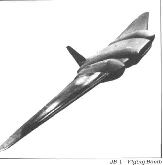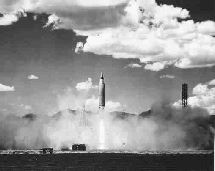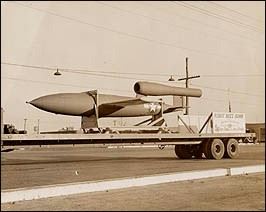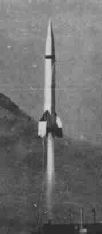Early Air Force Missile Development At the end of World War II, Army Air Force was testing captured German V-1 and V-2 missiles. Ford and Willys produced 1,391 JB-2 Loon missiles, the US version of the German V-1 Buzz Bomb before program termination in September 1945. Over 200 were tested. Northrop developed the JB-1 Flying Bomb, first launched in December 1944. The follow-on JB-10 was not a lot better in accuracy or performance than the original, and the program was terminated in March 1946. By April 1946, AAF had twelve surface-to-surface and three surface-to-air programs, including Nativ, Navaho, Matador, Hiroc, Snark, Boojum, Banshee, GAPA, Condor, Wizard, Thumper and several unnamed projects. These represented the full spectrum of propulsion systems (jet and rocket], airframe (cruise and ballistic), range (35 to 5,000 miles) and mission. Projects were designated by the letters MX. For example, the Matador was known as the MX-771A. By July 1947, the field was narrowed to Navaho 1, 2 and 3, Matador, Boojum, Banshee, GAPA, and Wizard. Boojum was a Northrop 5,000 mile range supersonic turbojet missile. Banshee was a drone version of the B-29, GAPA was an air defense weapon,and Wizard was a study in ballistic missile defense. Convair developed a V-2 derivative, the MX-774. Several concepts were carried into later ICBMs, including using gas/liquid pressure to support the airframe (Atlas), swiveling engines and a separating warhead. The program was terminated in July 1947. In 1949, the projects was narrowed even further, to Navaho, subsonic Snark, follow-on supersonic Boojum, and Banshee. After the cancellation of MX-774, funding for ICBMs was very limited until January 1951, when the Convair was funded for development of ballistic and cruise options for a 5,000 mile range missile carrying one of the current heavy nuclear warheads, with a CEP [circular error probable] of 1,500 feet. The cruise, or glide, option was dropped later that year, and funding and development was limited until 1955. In 1953, the Atomic Energy Commission developed the first smaller nuclear warhead, and in 1955, President Eisenhower, after the von Neumann and Rand reports recommended accelerated ICBM work, assigned the highest national priority to the Atlas and Titan. Western Development Division (WDD) in Southern Califomia, cooperating with SAC, was tasked to proceed to initial operating capability (IOC) with the two new systems. IOC was originally defined as to be able to launch 25% of the assigned 40 missiles at each of the three planned bases within 15 minutes, with another 10 launched within two hours. There was a mix of Atlas, Titan and Thor IRBMs between 1955 and 1957, with plans for varying totals, mixes and locations. The October 1957 launch of Sputnik changed all of the plans, with a great acceleration of all programs and an increase to the number of squadrons and missiles. |
|





